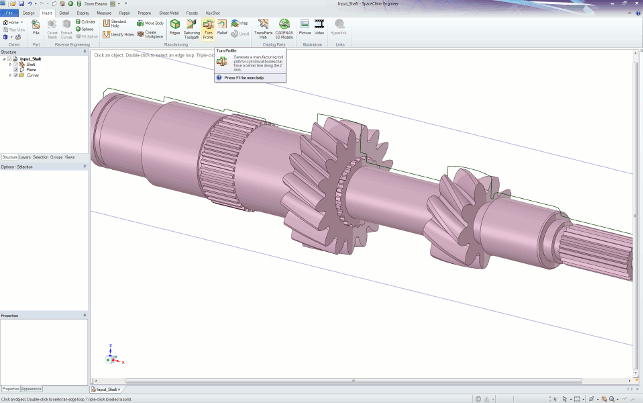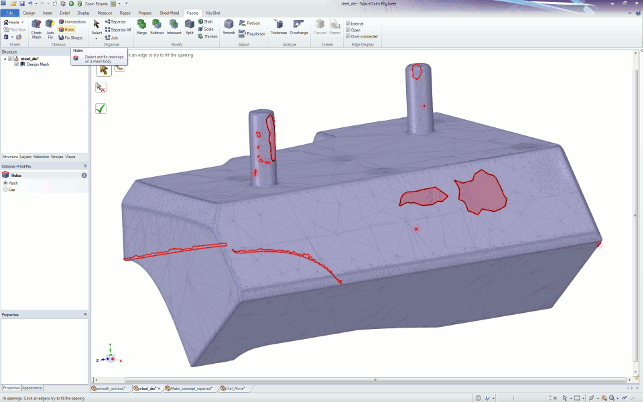When SpaceClaim was released in 2007 many in the 3D design industry wondered how it could take on the mighty among the long established players.

SpaceClaim continues to add to its sheet metal and manufacturing preparation tools
Its combination of direct modelling with a wealth of data import and export options meant that the system quickly found a home in those areas where there’s a need for occasional 3D CAD use, but without the overhead of more traditional parametric and history-based modelling systems.
This could be on the shopfloor for pre-processing before machining, in the sales office for big creation and quotation workflows or in the simulation office for model prep prior to meshing.
This last area has been a particular success, especially since the company linked up with simulation heavyweight, Ansys in 2009. This saw SpaceClaim added to Ansys’ price book and sold alongside its wealth of simulation specific systems.
So, it was with little surprise that 2013 saw Ansys acquire the company and bring it into the fold. It made huge sense as, while Ansys has always had its own modelling system (Design Modeler), it was showing its age and SpaceClaim offered a much more modern, all encompassing, set of tools for preparing models for simulation.
SpaceClaim 2015 is the first major release since then and it’s interesting to note that the acquisition hasn’t steered the system in a particular direction (in other words, toward simulation), but rather, the updates are across the board.
So let’s explore what SpaceClaim 2015 has to offer users in all areas.
Core capabilities
There have been a few major enhancements to the core modelling and data editing tools in SpaceClaim.
Many of these are generally applicable to everyone. From updates to improving surface extension (either tangential or normal led), through improvements to fi llets (which now support filleting to a point) and ordering of fillets (so you can get the form you want, rather than it being prescribed by the system).
There’s also been work done on reverse engineering. This picks up many of the updates made with respect to working with mesh data over the last couple of release cycles and formalises a set of tools to assist in taking a mesh, creating a series of sections and having the system create fi tted curves where those sections intersect with the geometry.
Prep for manufacturing
SpaceClaim has, since its earliest incarnations, had an interesting set of tools for manufacturing-specific operations.
From the sheet metal tools (driven by the company’s partnership with Trumpf) to the use of direct editing to assist with adding stock to models and such.

If you’re looking to build quick stock models or perhaps simplified profiles for CFD, then the new turn profiles will be super useful
This release sees updates to many of these areas, from the automated creation of corner reliefs — to assist with close fits in both machined and sheet metal die cut features — through to greater support for lathe work preparation.
These include deburring profi le creation and the ability to quickly extract a profile from turned components, which will be useful to both turn and mill/turn operators.
3D print support
Another area that’s seen a lot of work in more recent years, particularly since the company’s tie up with Geomagic (and now, 3D Systems), is the ability to work with mesh data.
As you’ll no doubt be aware, most systems don’t do a particularly good job of working with these facetted forms.

Work on mesh repair and rework continues with this release. Now with hole filling
What SpaceClaim has done is integrate the Polygonica libraries from MachineWorks and extend those tools. Whereas in previous releases, you were pretty much stuck with the mesh as is and had to work off that, you now have a greater spread of tools.
There are tools for finding and filling holes and spikes, with both planar and curvature based holes. There’s also a new set of facet manipulation tools for smoothing, thickening (shelling) facetted forms.
Additionally, there are some new tools to make meshes more consistent in terms of triangle shape. This means they’re more equilateral and as such more usable for simulation.
What’s interesting is that these are backed up with tools to ensure that what you’re doing to the mesh doesn’t deviate too far from what you want/need, including deviation mapping as well as mass property calculations.
Preprocessing for analysis
As you’d expect, this release also sees a fair amount of work done on the simulation preparation end of the spectrum.
While there’s been a consistent amount of integration and support for simulation workflows, it’s interesting to note that this release gets very specific. Much of the work done is targeting the creation of midplane modelling.
This is a tricky process at the best of times, so anything that helps is a good thing. There are tools to extract those mid-planes and extend and trim them into a cohesive mode.
Elsewhere, there are new tools to find troublesome features such as overlapped and corrupt faces and short edges.
Perhaps the most interesting tools are described in our workflow below and the assistance with both imprinting curves onto faces as well as wrapping 3D geometry to specific sets of curves.
While this has many applications (I’m thinking modelling spring back in stamped components, for instance), the one that immediately comes to mind is the modelling of flexible PCBs — whether to build a holistic model of your product or to setup thermal analyses.
Conclusion
Like a very small number of systems, such as Rhino, SpaceClaim is a Swiss army knife of a design system.
The things that it excels at vary between users and organisations that use it. That said, there’s a common link in that they all have tasks to perform that are specialist and aren’t supported by the mainstream 3D design systems.
Since Ansys acquired the software, we’ve seen two good solid releases that have raised the level of support for a variety of tasks and industry areas, from manufacturing preparation, through 3D print related items (I’m still not convinced this is a huge market… yet) and, of course, simulation and analysis.
So, it looks like Ansys is giving the team room to breathe and SpaceClaim, as a design tool, is maturing nicely.
| Product | SpaceClaim 2015 |
|---|---|
| Company name | Ansys |
| Price | on application |







